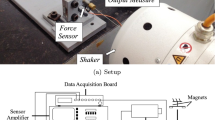Abstract
The Volterra series is commonly used for the modeling of nonlinear dynamical systems. In general, however, a large number of terms are needed to represent Volterra kernels, with the number of required terms increasing exponentially with the order of the kernel. Therefore, reduced-order kernel representations are needed in order to employ the Volterra series in engineering practice. This paper presents an approach whereby multiwavelets are used to obtain low-order estimates of first-, second-, and third-order Volterra kernels. A family of multiwavelets is constructed from the classical finite element basis functions using the technique of intertwining. The resulting multiwavelets are piecewise-polynomial, orthonormal, compactly-supported, and can be constructed with arbitrary approximation order. Furthermore, these multiwavelets are easily adapted to the domains of support of the Volterra kernels. In contrast, most wavelet families do not possess this characteristic. Higher-dimensional multiwavelets can easily be constructed by taking tensor products of the original one-dimensional functions. Therefore, it is straightforward to extend this approach to the representation of higher-order Volterra kernels. This kernel identification algorithm is demonstrated on a prototypical oscillator with a quadratic stiffness nonlinearity. For this system, it is shown that accurate kernel estimates can be obtained in terms of a relatively small number of wavelet coefficients. These results indicate the potential of the multiwavelet-based algorithm for obtaining reduced-order models for a large class of weakly nonlinear systems.
Similar content being viewed by others
References
Chon, K., Chen, Y., Holstein-Rathlou, N.-H., and Marmarelis, V., ‘Nonlinear system analysis of renal autoregulation in normotensive and hypertensive rats,’ IEEE Transactions on Biomedical Engineering 45(3), 1998, 342–353.
French, A. S., Sekizawa, S., Hoger, U., and Torkkeli, P., ‘Predicting the responses of mechanoreceptor neurons to physiological inputs by nonlinear system identification,’ Annals of Biomedical Engineering 19, 2001, 187–194.
Marzocca, P., Librescu, L., and Silva, W. A., ‘Aeroelastic response of nonlinear wing sections using a functional series technique,’ AIAA Journal 40(5), 2002, 813–824.
Silva, W., ‘Application of nonlinear systems theory to transonic unsteady aerodynamic responses,’ Journal of Aircraft 30(5), 1993, 660–668.
Silva, W., Discrete-Time Linear and Nonlinear Aerodynamic Impulse Responses for Efficient CFD Analyses, Ph.D. Dissertation, The College of William & Mary, Williamsburg, Virginia, 1997.
Cherry, J. A. and Snelgrove, W. M., ‘On the characterization and reduction of distortion in bandpass filters,’ IEEE Transactions on Circuits and Systems I: Fundamental Theory and Applications 45(5), 1998, 523–537.
Borys, A., Nonlinear Aspects of Telecommunications: Discrete Volterra Series and Nonlinear Echo Cancellation, CRC, New York, 2001.
Doyle, F. J., III, Pearson, R. K., and Ogunnaike, B. A., Identification and Control Using Volterra Models, Springer, London, 2002.
Lee, Y. W. and Schetzen, M., ‘Measuring of the Wiener kernels of a nonlinear system by cross-correlation,’ International Journal of Control 2(3), 1965, 237–254.
Boyd, S., Tang, Y. S., and Chua, L. O., ‘Measuring Volterra kernels,’ IEEE Transactions on Circuits and Systems 30(8), 1983, 571–577.
Wray, J. and Green, G., ‘Calculation of the Volterra kernels of nonlinear dynamic systems using an artificial neural network,’ Biological Cybernetics 71(3), 1994, 187–195.
Marmarelis, V. Z., ‘Identification of nonlinear biological systems using Laguerre expansions of kernels,’ Annals of Biomedical Engineering 21, 1993, 573–589.
Reisenthel, P., ‘Prediction of unsteady aerodynamic forces via nonlinear kernel identification,’ in International Forum on Aeroelasticity and Structural Dynamics, Williamsburg, VA, 1999.
Beylkin, G., Coifman, R., and Rokhlin, V., ‘Fast wavelet transforms and numerical algorithms,’ Communications on Pure and Applied Mathematics 44, 1991, 141–183.
Nikolaou, M. and Mantha, D., ‘Efficient nonlinear modelling using wavelets and related compression techniques,’ in NSF Workshop on Nonlinear Model Predictive Control, Ascona, Switzerland, 1998.
Chou, K. C. and Guthart, G. S., ‘Representation of Green's function integral operators using wavelet transforms,’ Journal of Vibration and Control 6, 2000, 19–48.
Kurdila, A. J., Prazenica, R. J., Rediniotis, O., and Strganac, T., ‘Multiresolution methods for reduced-order models for dynamical systems,’ Journal of Guidance, Control, and Dynamics 24(2), 2001, 193–200.
Cohen, A., Daubechies, I., and Feauveau, J. C., ‘Biorthogonal bases of compactly supported wavelets,’ Communications in Pure and Applied Mathematics 45, 1992, 485–559.
Prazenica, R. J. and Kurdila, A. J., ‘Volterra kernel identification using triangular wavelets,’ Journal of Vibration and Control 10(4), 2004, 597–622.
Donovan, G., Geronimo, J., and Hardin, D., ‘Intertwining multiresolution analyses and the construction of piecewise-polynomial wavelets,’ SIAM Journal of Mathematical Analysis 27(6), 1996, 1791–1815.
Donovan, G., Geronimo, J., and Hardin, D., ‘Orthogonal polynomials and the construction of piecewise-polynomial smooth wavelets,’ SIAM Journal of Mathematical Analysis 30(5), 1999, 1029–1056.
Rugh, W. J., Nonlinear System Theory: The Volterra–Wiener Approach, Johns Hopkins University Press, Baltimore, MD, 1980.
Schetzen, M., The Volterra and Wiener Theories of Nonlinear Systems, Wiley, New York, 1980.
Boyd, S. and Chua, L. O., ‘Fading memory and the problem of approximating nonlinear operators with Volterra series,’ IEEE Transactions on Circuits and Systems CAS-32(11), 1985, 1150–1161.
Mallat, S., A Wavelet Tour of Signal Processing, Academic, New York, 1999.
Groetsch, C. W., Inverse Problems in the Mathematical Sciences, Vieweg, Wiesbaden, Germany, 1993.
Hansen, P. C., Rank Deficient and Discrete Ill-Posed Problems, SIAM, Philadelphia, PA, 1998.
Worden, K. and Tomlinson, G. R., Nonlinearity in Structural Dynamics: Detection, Identification, and Modelling, Institute of Physics, Philadelphia, PA, 2001.
Prazenica, R. J., Brenner, M. J., and Lind, R., ‘Nonlinear Volterra kernel identification for the F/A-18 active aeroelastic wing,’ in International Forum on Aeroelasticity and Structural Dynamics, Amsterdam, The Netherlands, 2003.
Author information
Authors and Affiliations
Corresponding author
Rights and permissions
About this article
Cite this article
Prazenica, R.J., Kurdila, A.J. Multiwavelet Constructions and Volterra Kernel Identification. Nonlinear Dyn 43, 277–310 (2006). https://doi.org/10.1007/s11071-006-8323-x
Received:
Accepted:
Issue Date:
DOI: https://doi.org/10.1007/s11071-006-8323-x




